tires TOYOTA RAV4 HYBRID 2020 Warranties & Maintenance Guides (in English)
[x] Cancel search | Manufacturer: TOYOTA, Model Year: 2020, Model line: RAV4 HYBRID, Model: TOYOTA RAV4 HYBRID 2020Pages: 260, PDF Size: 8.54 MB
Page 73 of 260
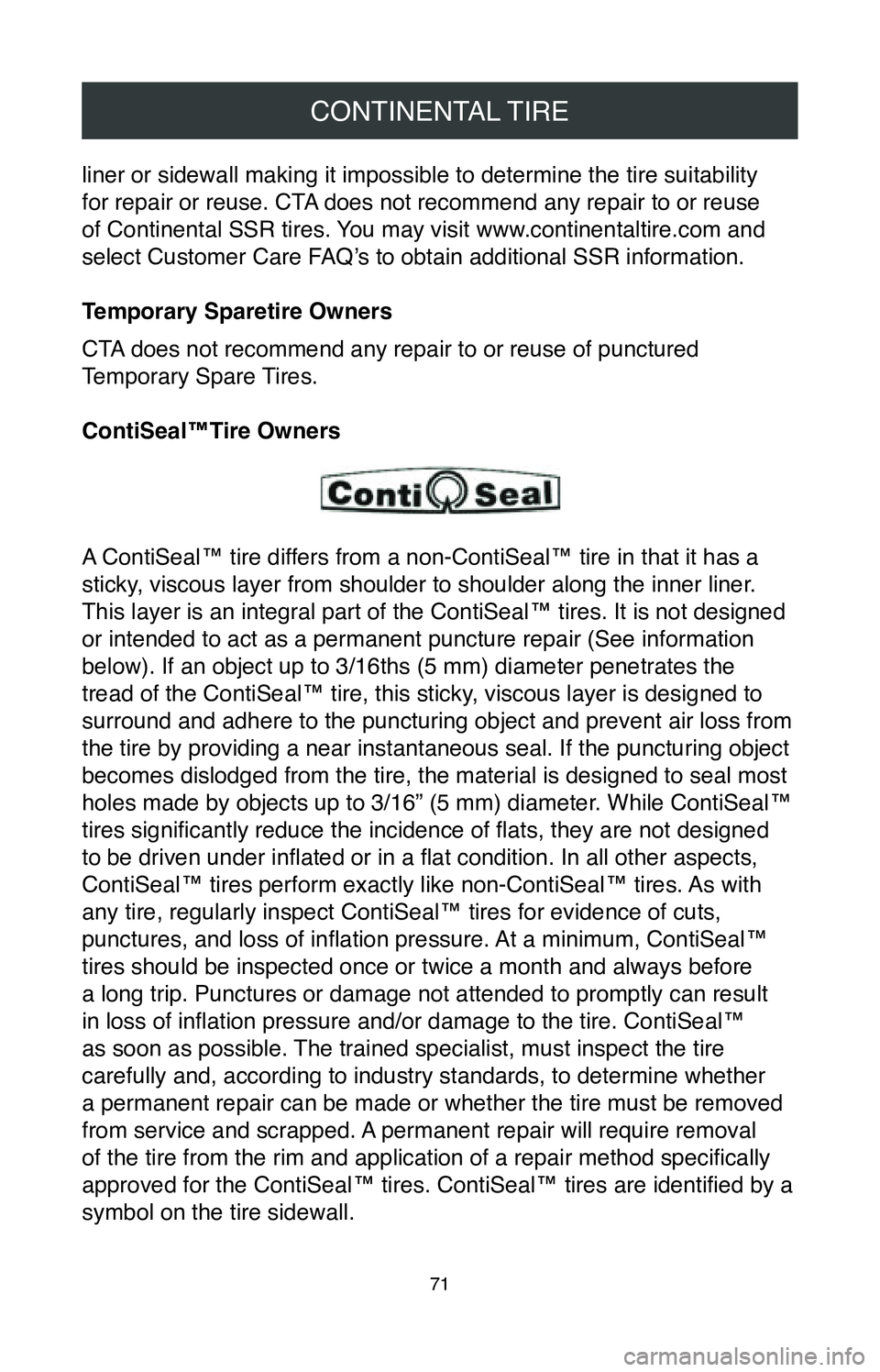
CONTINENTAL TIRE
71
liner or sidewall making it impossible to determine the tire suitability\
for repair or reuse. CTA does not recommend any repair to or reuse
of Continental SSR tires. You may visit www.continentaltire.com and
select Customer Care FAQ’s to obtain additional SSR information.
Temporary Sparetire Owners
CTA does not recommend any repair to or reuse of punctured
Temporary Spare Tires.
ContiSeal‚ĄĘTire Owners
A ContiSeal‚ĄĘ tire differs from a non-ContiSeal‚ĄĘ tire in that it has a
sticky, viscous layer from shoulder to shoulder along the inner liner.
This layer is an integral part of the ContiSeal‚ĄĘ tires. It is not des\
igned
or intended to act as a permanent puncture repair (See information
below). If an object up to 3/16ths (5 mm) diameter penetrates the
tread of the ContiSeal‚ĄĘ tire, this sticky, viscous layer is designed to
surround and adhere to the puncturing object and prevent air loss from
the tire by providing a near instantaneous seal. If the puncturing object
becomes dislodged from the tire, the material is designed to seal most
holes made by objects up to 3/16‚ÄĚ (5 mm) diameter. While ContiSeal‚ĄĘ
tires significantly reduce the incidence of flats, they are not designed
to be driven under inflated or in a flat condition. In all other aspects,
ContiSeal‚ĄĘ tires perform exactly like non-ContiSeal‚ĄĘ tires. As with
any tire, regularly inspect ContiSeal‚ĄĘ tires for evidence of cuts,
punctures, and loss of inflation pressure. At a minimum, ContiSeal‚ĄĘ
tires should be inspected once or twice a month and always before
a long trip. Punctures or damage not attended to promptly can result
in loss of inflation pressure and/or damage to the tire. ContiSeal‚ĄĘ
as soon as possible. The trained specialist, must inspect the tire
carefully and, according to industry standards, to determine whether
a permanent repair can be made or whether the tire must be removed
from service and scrapped. A permanent repair will require removal
of the tire from the rim and application of a repair method specifically
approved for the ContiSeal‚ĄĘ tires. ContiSeal‚ĄĘ tires are identified by a
symbol on the tire sidewall.
Page 74 of 260
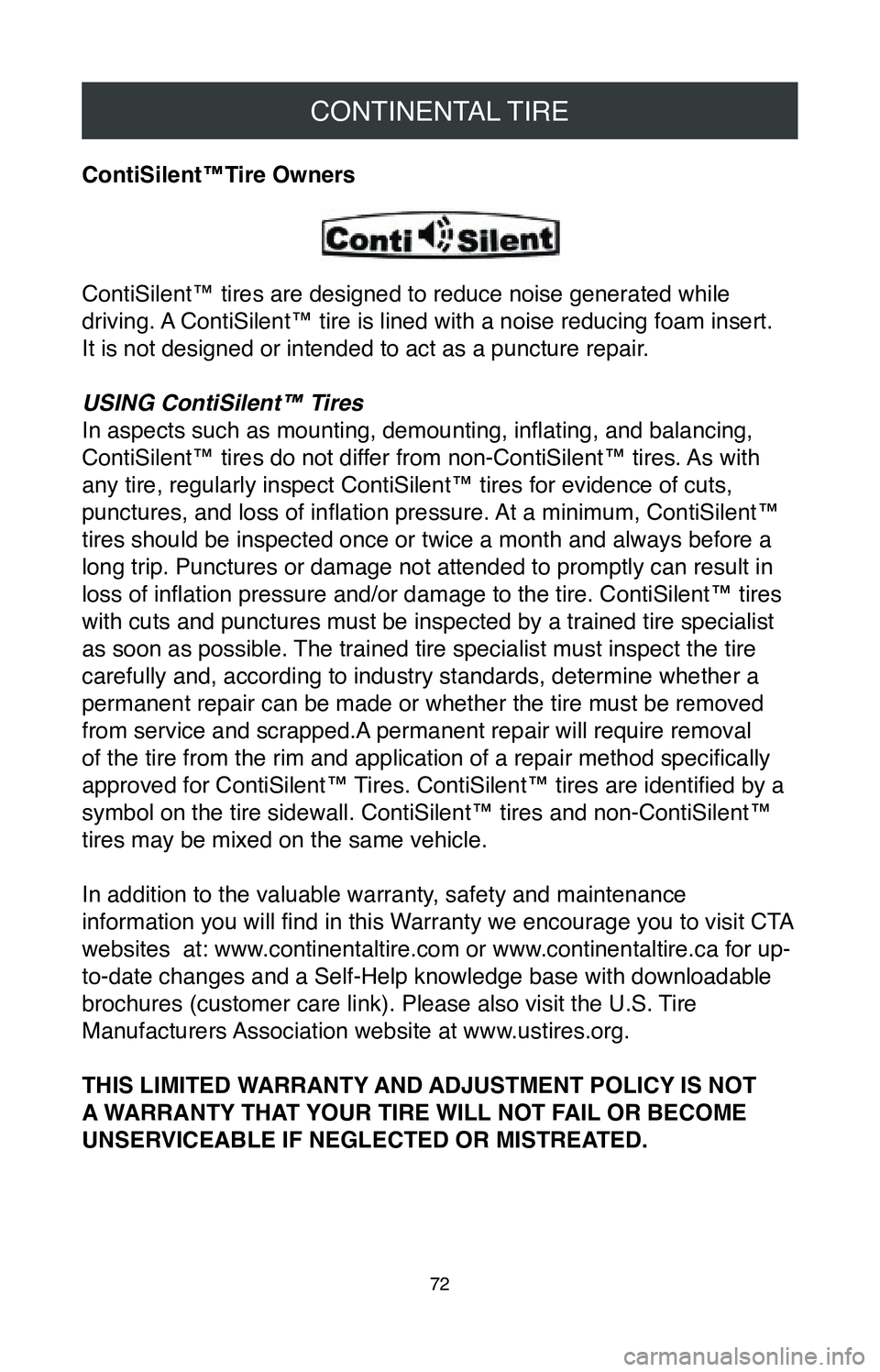
CONTINENTAL TIRE
72
ContiSilent‚ĄĘTire Owners
ContiSilent‚ĄĘ tires are designed to reduce noise generated while
driving. A ContiSilent‚ĄĘ tire is lined with a noise reducing foam insert.
It is not designed or intended to act as a puncture repair.
USING ContiSilent‚ĄĘ Tires
In aspects such as mounting, demounting, inflating, and balancing,
ContiSilent‚ĄĘ tires do not differ from non-ContiSilent‚ĄĘ tires. As with
any tire, regularly inspect ContiSilent‚ĄĘ tires for evidence of cuts, \
punctures, and loss of inflation pressure. At a minimum, ContiSilent‚ĄĘ
tires should be inspected once or twice a month and always before a
long trip. Punctures or damage not attended to promptly can result in
loss of inflation pressure and/or damage to the tire. ContiSilent‚ĄĘ tires
with cuts and punctures must be inspected by a trained tire specialist
as soon as possible. The trained tire specialist must inspect the tire
carefully and, according to industry standards, determine whether a
permanent repair can be made or whether the tire must be removed
from service and scrapped.A permanent repair will require removal
of the tire from the rim and application of a repair method specifically
approved for ContiSilent‚ĄĘ Tires. ContiSilent‚ĄĘ tires are identified by a
symbol on the tire sidewall. ContiSilent‚ĄĘ tires and non-ContiSilent‚ĄĘ
tires may be mixed on the same vehicle.
In addition to the valuable warranty, safety and maintenance
information you will find in this Warranty we encourage you to visit CTA
websites at: www.continentaltire.com or www.continentaltire.ca for up-
to-date changes and a Self-Help knowledge base with downloadable
brochures (customer care link). Please also visit the U.S. Tire
Manufacturers Association website at www.ustires.org.
THIS LIMITED WARRANTY AND ADJUSTMENT POLICY IS NOT
A WARRANTY THAT YOUR TIRE WILL NOT FAIL OR BECOME
UNSERVICEABLE IF NEGLECTED OR MISTREATED.
Page 76 of 260
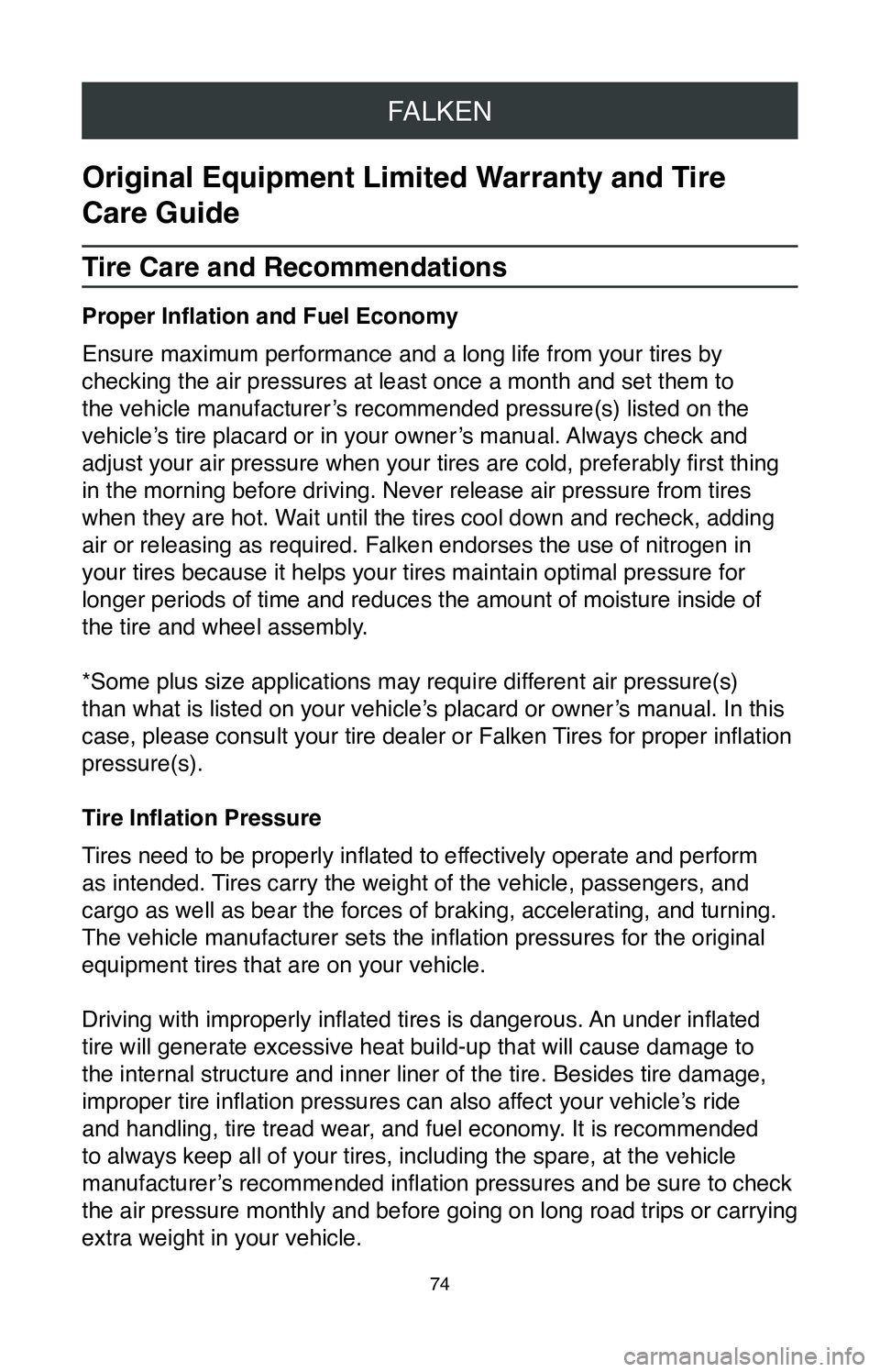
FALKEN
74
Original Equipment Limited Warranty and Tire
Care Guide
Tire Care and Recommendations
Proper Inflation and Fuel Economy
Ensure maximum performance and a long life from your tires by
checking the air pressures at least once a month and set them to
the vehicle manufacturer’s recommended pressure(s) listed on the
vehicle’s tire placard or in your owner’s manual. Always check and
adjust your air pressure when your tires are cold, preferably first thing
in the morning before driving. Never release air pressure from tires
when they are hot. Wait until the tires cool down and recheck, adding
air or releasing as required. Falken endorses the use of nitrogen in
your tires because it helps your tires maintain optimal pressure for
longer periods of time and reduces the amount of moisture inside of
the tire and wheel assembly.
*Some plus size applications may require different air pressure(s)
than what is listed on your vehicle’s placard or owner’s manual. In this
case, please consult your tire dealer or Falken Tires for proper inflation
pressure(s).
Tire Inflation Pressure
Tires need to be properly inflated to effectively operate and perform
as intended. Tires carry the weight of the vehicle, passengers, and
cargo as well as bear the forces of braking, accelerating, and turning. \
The vehicle manufacturer sets the inflation pressures for the original
equipment tires that are on your vehicle.
Driving with improperly inflated tires is dangerous. An under inflated
tire will generate excessive heat build-up that will cause damage to
the internal structure and inner liner of the tire. Besides tire damage,\
improper tire inflation pressures can also affect your vehicle’s ride
and handling, tire tread wear, and fuel economy. It is recommended
to always keep all of your tires, including the spare, at the vehicle
manufacturer’s recommended inflation pressures and be sure to check
the air pressure monthly and before going on long road trips or carrying
extra weight in your vehicle.
Page 77 of 260
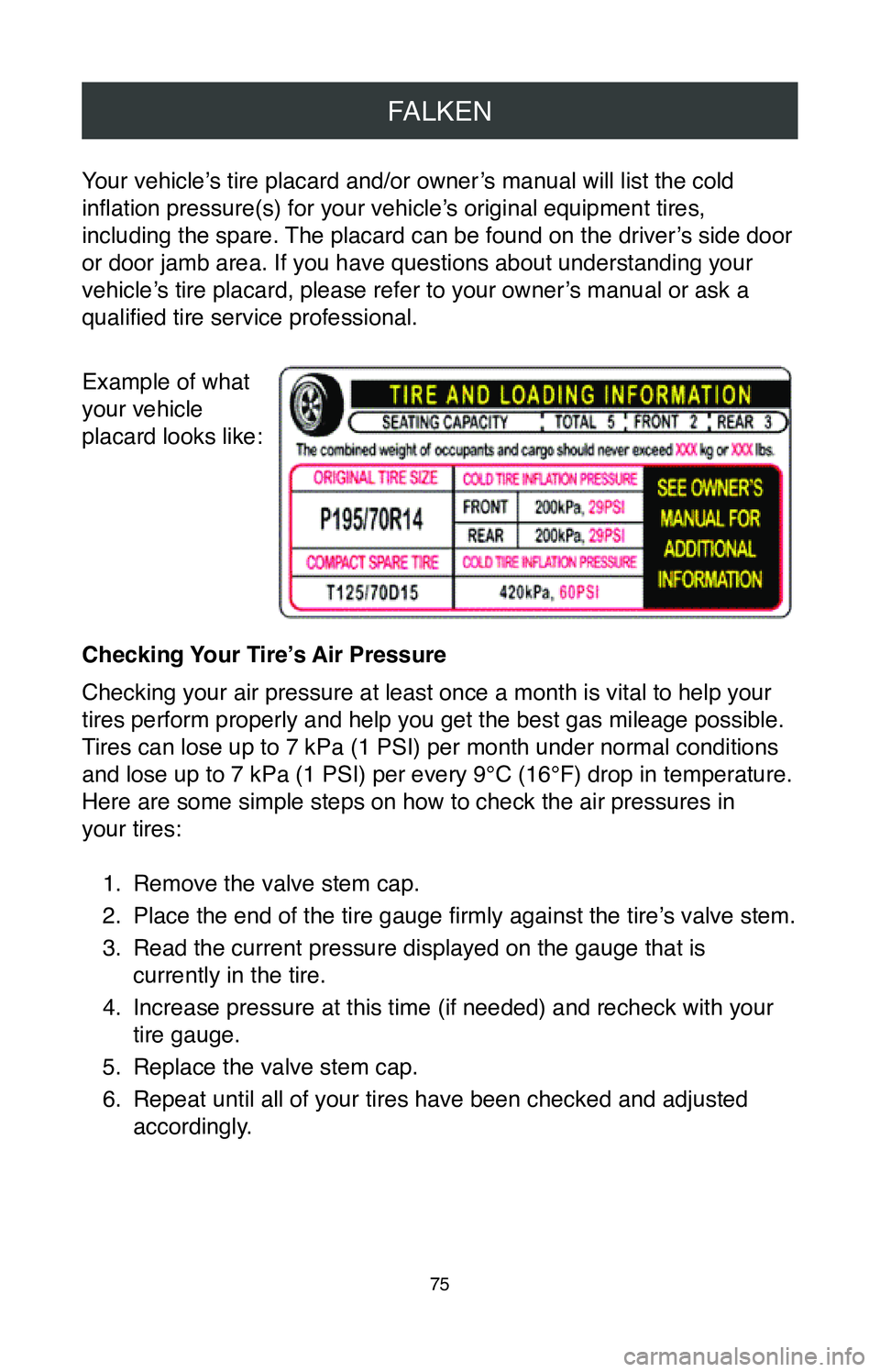
FALKEN
75
Your vehicle’s tire placard and/or owner’s manual will list the cold
inflation pressure(s) for your vehicle’s original equipment tires,
including the spare. The placard can be found on the driver’s side door
or door jamb area. If you have questions about understanding your
vehicle’s tire placard, please refer to your owner’s manual or ask a
qualified tire service professional.
Example of what
your vehicle
placard looks like:
Checking Your Tire’s Air Pressure
Checking your air pressure at least once a month is vital to help your
tires perform properly and help you get the best gas mileage possible.
Tires can lose up to 7 kPa (1 PSI) per month under normal conditions
and lose up to 7 kPa (1 PSI) per every 9¬įC (16¬įF) drop in temperature.
Here are some simple steps on how to check the air pressures in
your tires:1.
Remove the valve stem cap.
2.
Place the end of the tire gauge firmly against the tire’s valve stem.
3.
Read the current pressure displayed on the gauge that is
currently in the tire.
4.
Increase pressure at this time (if needed) and recheck with your
tire gauge.
5.
Replace the valve stem cap.
6.
Repeat until all of your tires have been checked and adjusted
accordingly.
Page 78 of 260
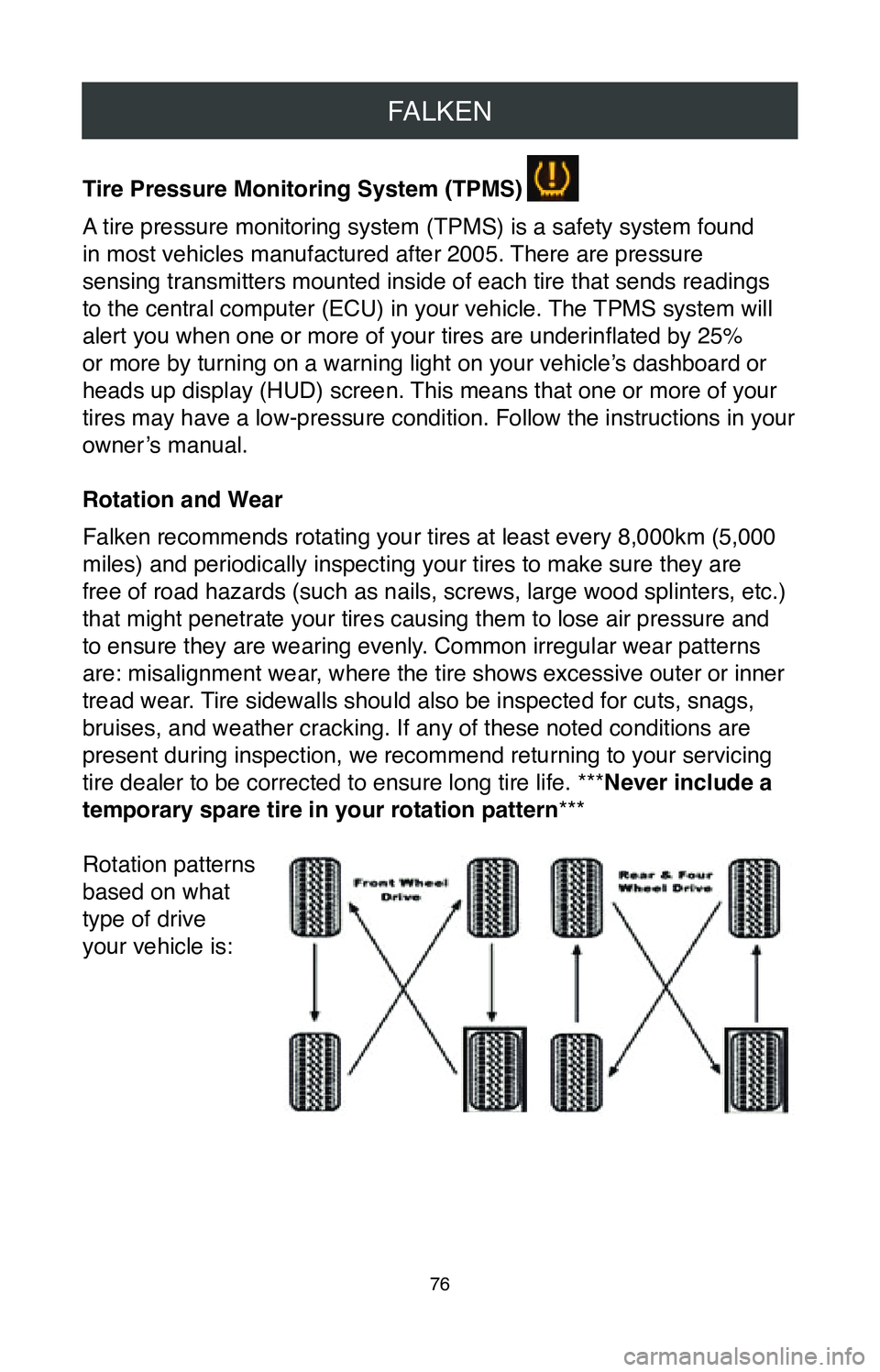
FALKEN
76
Tire Pressure Monitoring System (TPMS)
A tire pressure monitoring system (TPMS) is a safety system found
in most vehicles manufactured after 2005. There are pressure
sensing transmitters mounted inside of each tire that sends readings
to the central computer (ECU) in your vehicle. The TPMS system will
alert you when one or more of your tires are underinflated by 25%
or more by turning on a warning light on your vehicle’s dashboard or
heads up display (HUD) screen. This means that one or more of your
tires may have a low-pressure condition. Follow the instructions in your
owner’s manual.
Rotation and Wear
Falken recommends rotating your tires at least every 8,000km (5,000
miles) and periodically inspecting your tires to make sure they are
free of road hazards (such as nails, screws, large wood splinters, etc.)
that might penetrate your tires causing them to lose air pressure and
to ensure they are wearing evenly. Common irregular wear patterns
are: misalignment wear, where the tire shows excessive outer or inner
tread wear. Tire sidewalls should also be inspected for cuts, snags,
bruises, and weather cracking. If any of these noted conditions are
present during inspection, we recommend returning to your servicing
tire dealer to be corrected to ensure long tire life. ***Never include a
temporary spare tire in your rotation pattern***
Rotation patterns
based on what
type of drive
your vehicle is:
Page 79 of 260
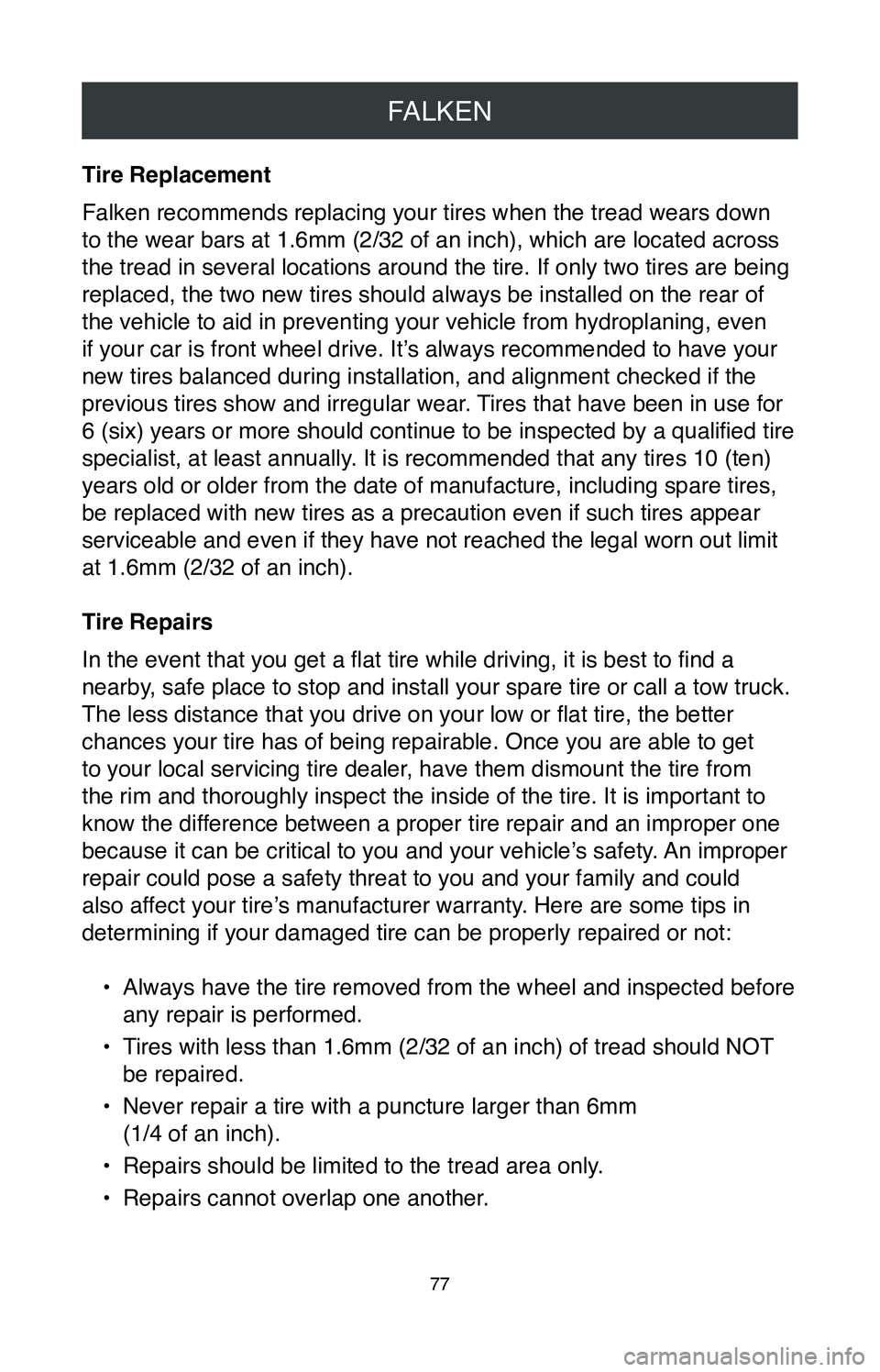
FALKEN
77
Tire Replacement
Falken recommends replacing your tires when the tread wears down
to the wear bars at 1.6mm (2/32 of an inch), which are located across
the tread in several locations around the tire. If only two tires are be\
ing
replaced, the two new tires should always be installed on the rear of
the vehicle to aid in preventing your vehicle from hydroplaning, even
if your car is front wheel drive. It’s always recommended to have your
new tires balanced during installation, and alignment checked if the
previous tires show and irregular wear. Tires that have been in use for
6 (six) years or more should continue to be inspected by a qualified tire
specialist, at least annually. It is recommended that any tires 10 (ten)
years old or older from the date of manufacture, including spare tires, \
be replaced with new tires as a precaution even if such tires appear
serviceable and even if they have not reached the legal worn out limit
at 1.6mm (2/32 of an inch).
Tire Repairs
In the event that you get a flat tire while driving, it is best to find a
nearby, safe place to stop and install your spare tire or call a tow truck.
The less distance that you drive on your low or flat tire, the better
chances your tire has of being repairable. Once you are able to get
to your local servicing tire dealer, have them dismount the tire from
the rim and thoroughly inspect the inside of the tire. It is important t\
o
know the difference between a proper tire repair and an improper one
because it can be critical to you and your vehicle’s safety. An improper
repair could pose a safety threat to you and your family and could
also affect your tire’s manufacturer warranty. Here are some tips in
determining if your damaged tire can be properly repaired or not:‚ÄĘ
Always have the tire removed from the wheel and inspected before
any repair is performed.
‚ÄĘ
Tires with less than 1.6mm (2/32 of an inch) of tread should NOT
be repaired.
‚ÄĘ
Never repair a tire with a puncture larger than 6mm
(1/4 of an inch).
‚ÄĘ
Repairs should be limited to the tread area only.
‚ÄĘ
Repairs cannot overlap one another.
Page 80 of 260
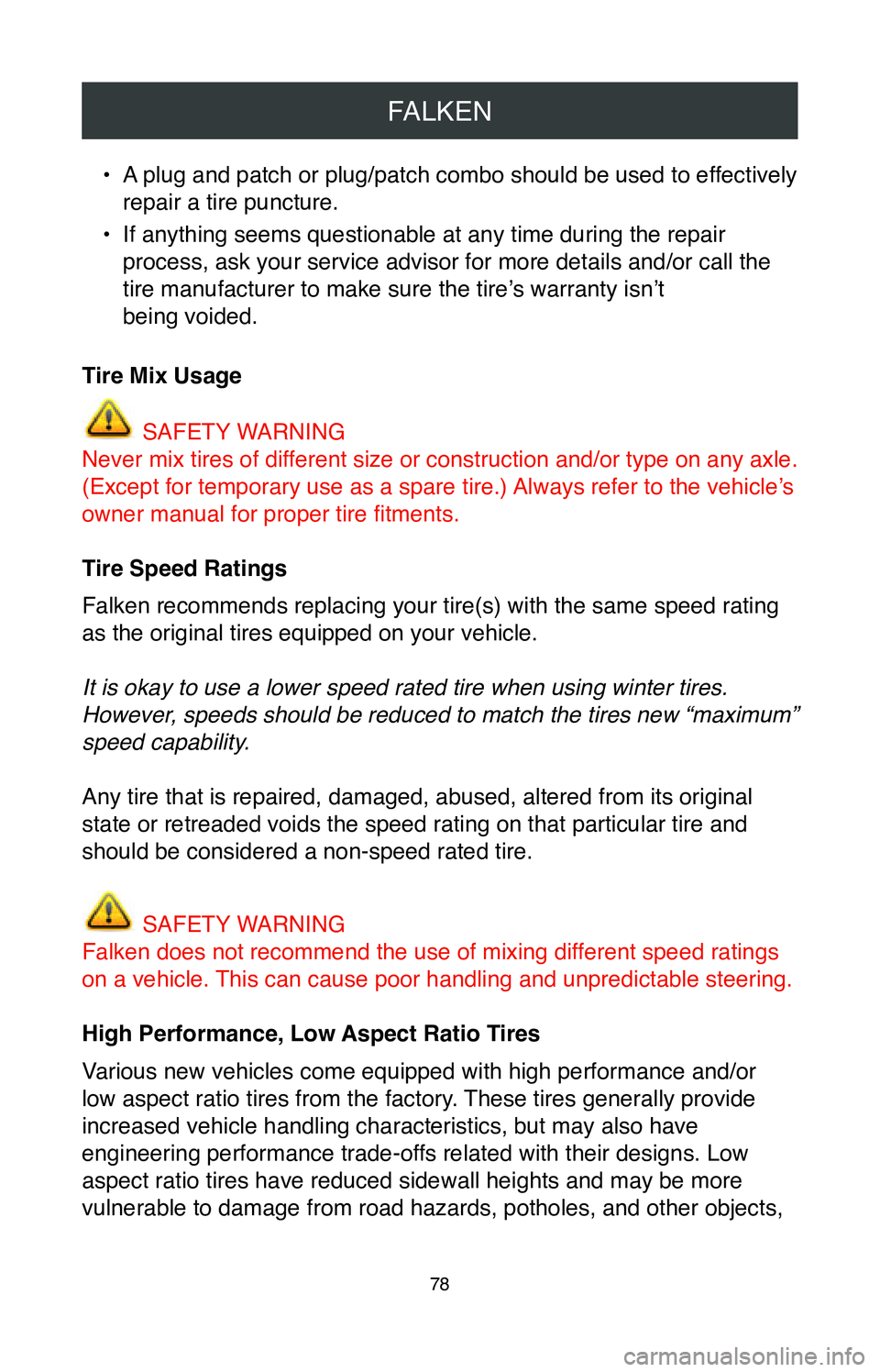
FALKEN
78
‚ÄĘ A plug and patch or plug/patch combo should be used to effectively
repair a tire puncture.
‚ÄĘ
If anything seems questionable at any time during the repair
process, ask your service advisor for more details and/or call the
tire manufacturer to make sure the tire’s warranty isn’t
being voided.
Tire Mix Usage
SAFETY WARNING
Never mix tires of different size or construction and/or type on any axle.
(Except for temporary use as a spare tire.) Always refer to the vehicle’s
owner manual for proper tire fitments.
Tire Speed Ratings
Falken recommends replacing your tire(s) with the same speed rating
as the original tires equipped on your vehicle.
It is okay to use a lower speed rated tire when using winter tires.
However, speeds should be reduced to match the tires new ‚Äúmaximum‚ÄĚ
speed capability.
Any tire that is repaired, damaged, abused, altered from its original
state or retreaded voids the speed rating on that particular tire and
should be considered a non-speed rated tire.
SAFETY WARNING
Falken does not recommend the use of mixing different speed ratings
on a vehicle. This can cause poor handling and unpredictable steering.
High Performance, Low Aspect Ratio Tires
Various new vehicles come equipped with high performance and/or
low aspect ratio tires from the factory. These tires generally provide
increased vehicle handling characteristics, but may also have
engineering performance trade-offs related with their designs. Low
aspect ratio tires have reduced sidewall heights and may be more
vulnerable to damage from road hazards, potholes, and other objects,
Page 81 of 260

FALKEN
79
like curbs. Your vehicle’s wheels are susceptible to these same
dangers as well. Some vehicles may be originally equipped with high
performance tires that are designed for warmer weather use reducing
traction in colder, winter weather conditions. High performance tires
also pose the possibility of wearing more quickly, giving a stiffer ride,
and producing louder noise than standard all-season tires during
operation. Refer to your vehicle owner’s manual, tire information
placard, or qualified tire service professional for more information about
these kinds of tires.
Winter Tires
Falken recommends all four tires be replaced when replacing your
original equipment tires and installing winter tires for the winter mont\
hs.
SAFETY WARNING
Never use just two winter tires. It could lead to adverse handling, loss
of control, which could cause serious injury or death.
Storing Your Tires
When storing your tires for any extended period of time, be sure to
thoroughly clean your tires with a tire brush, soap, and water to remove\
any dirt, salt, and brake dust from the tires. If you are storing your
tires still mounted on the wheels, use a wheel brush and approved
wheel cleaner to clean your wheels. Then dry the wheels and tires
with a towel and allow them to fully dry. DO NOT apply any tire
dressings while storing your tires. Tire compounds are made to resist
weather cracking and ozone damage. Place each clean and dry tire
in an airtight plastic bag and seal the bag with tape to help reduce oil\
evaporation. Store your tires out of direct sunlight and somewhere that \
is well shielded from the elements, like a climate-controlled room or
dry basement. Storing the tires in a garage or shed usually exposes
the tires to a wide range of temperatures as well as precipitation and
humidity. Keep the tires away from sources that emit ozone like electric
motors that use contact brushes, furnaces, sump pumps, etc. Although
tires will still age regardless of how they are stored, these precaution\
s
will help slow the aging process and reduce the damage to your tires.
Page 82 of 260
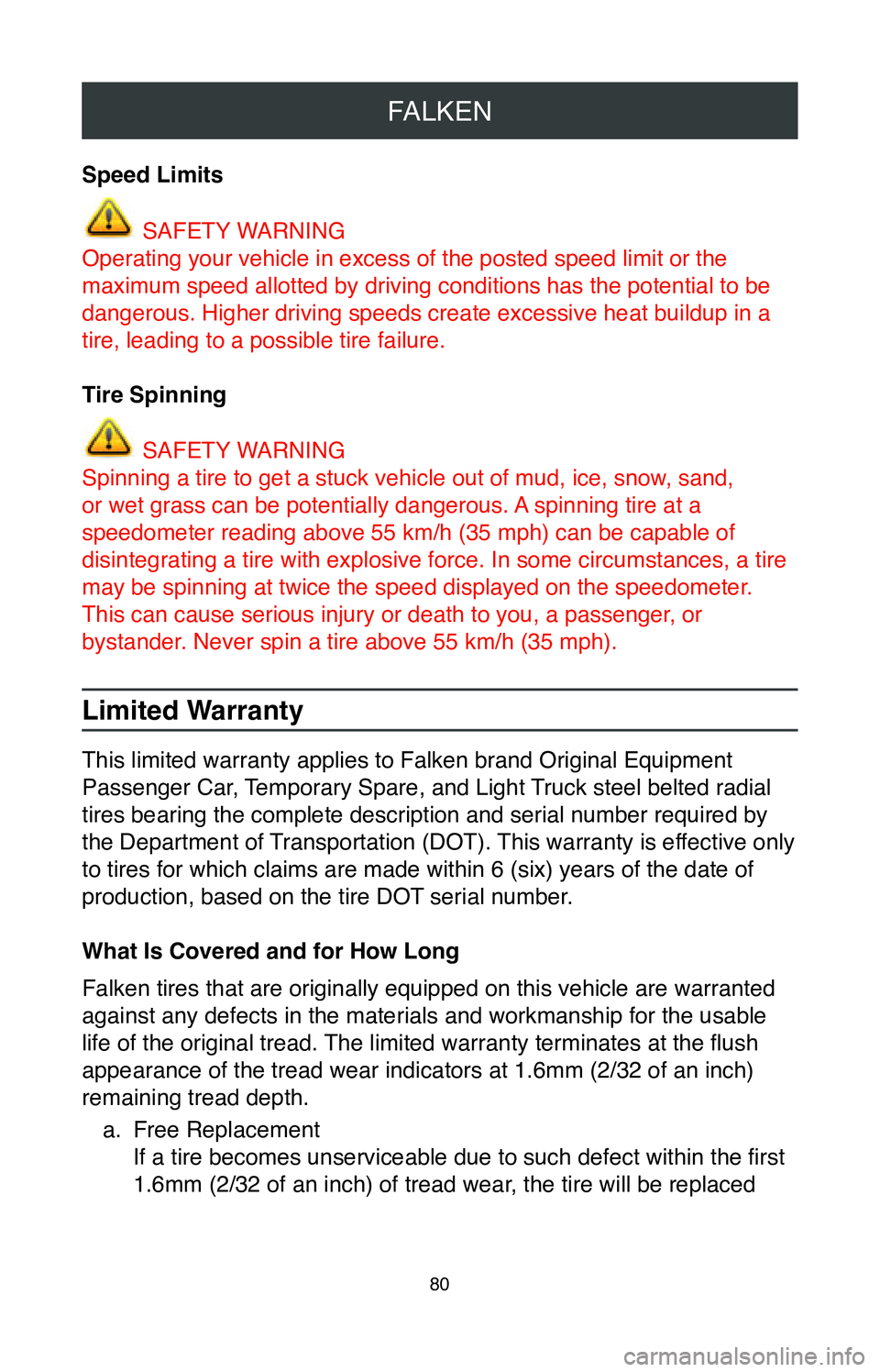
FALKEN
80
Speed Limits
SAFETY WARNING
Operating your vehicle in excess of the posted speed limit or the
maximum speed allotted by driving conditions has the potential to be
dangerous. Higher driving speeds create excessive heat buildup in a
tire, leading to a possible tire failure.
Tire Spinning
SAFETY WARNING
Spinning a tire to get a stuck vehicle out of mud, ice, snow, sand,
or wet grass can be potentially dangerous. A spinning tire at a
speedometer reading above 55 km/h (35 mph) can be capable of
disintegrating a tire with explosive force. In some circumstances, a tir\
e
may be spinning at twice the speed displayed on the speedometer.
This can cause serious injury or death to you, a passenger, or
bystander. Never spin a tire above 55 km/h (35 mph).
Limited Warranty
This limited warranty applies to Falken brand Original Equipment
Passenger Car, Temporary Spare, and Light Truck steel belted radial
tires bearing the complete description and serial number required by
the Department of Transportation (DOT). This warranty is effective only
to tires for which claims are made within 6 (six) years of the date of
production, based on the tire DOT serial number.
What Is Covered and for How Long
Falken tires that are originally equipped on this vehicle are warranted \
against any defects in the materials and workmanship for the usable
life of the original tread. The limited warranty terminates at the flush
appearance of the tread wear indicators at 1.6mm (2/32 of an inch)
remaining tread depth.
a.
Free Replacement
If a tire becomes unserviceable due to such defect within the first
1.6mm (2/32 of an inch) of tread wear, the tire will be replaced
Page 83 of 260
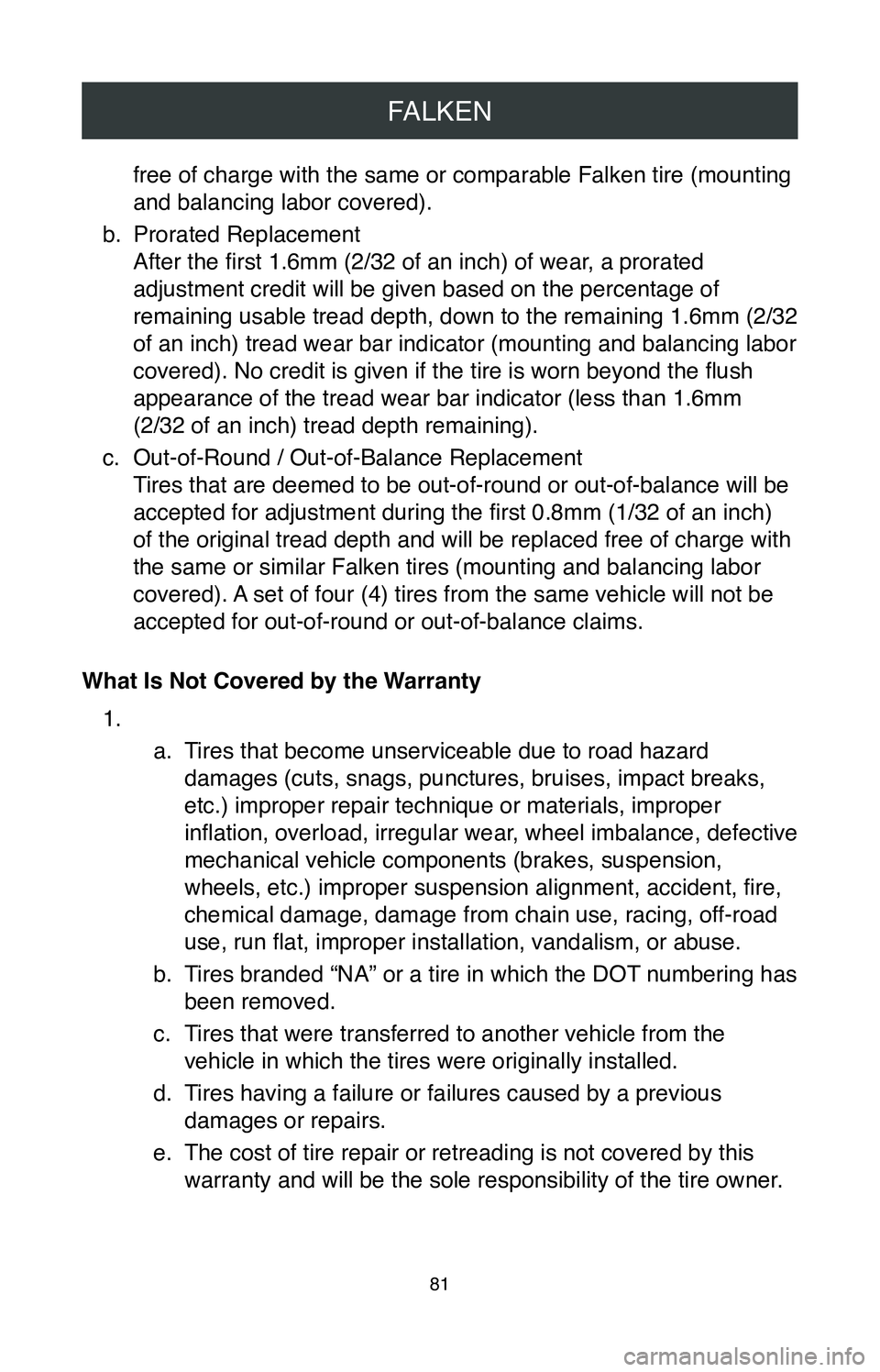
FALKEN
81
free of charge with the same or comparable Falken tire (mounting
and balancing labor covered).
b.
Prorated Replacement
After the first 1.6mm (2/32 of an inch) of wear, a prorated
adjustment credit will be given based on the percentage of
remaining usable tread depth, down to the remaining 1.6mm (2/32
of an inch) tread wear bar indicator (mounting and balancing labor
covered). No credit is given if the tire is worn beyond the flush
appearance of the tread wear bar indicator (less than 1.6mm
(2/32 of an inch) tread depth remaining).
c.
Out-of-Round / Out-of-Balance Replacement
Tires that are deemed to be out-of-round or out-of-balance will be
accepted for adjustment during the first 0.8mm (1/32 of an inch)
of the original tread depth and will be replaced free of charge with
the same or similar Falken tires (mounting and balancing labor
covered). A set of four (4) tires from the same vehicle will not be
accepted for out-of-round or out-of-balance claims.
What Is Not Covered by the Warranty 1.
a. Tires that become unserviceable due to road hazard
damages (cuts, snags, punctures, bruises, impact breaks,
etc.) improper repair technique or materials, improper
inflation, overload, irregular wear, wheel imbalance, defective
mechanical vehicle components (brakes, suspension,
wheels, etc.) improper suspension alignment, accident, fire,
chemical damage, damage from chain use, racing, off-road
use, run flat, improper installation, vandalism, or abuse.
b.
Tires branded ‚ÄúNA‚ÄĚ or a tire in which the DOT numbering has
been removed.
c.
Tires that were transferred to another vehicle from the
vehicle in which the tires were originally installed.
d.
Tires having a failure or failures caused by a previous
damages or repairs.
e.
The cost of tire repair or retreading is not covered by this
warranty and will be the sole responsibility of the tire owner.